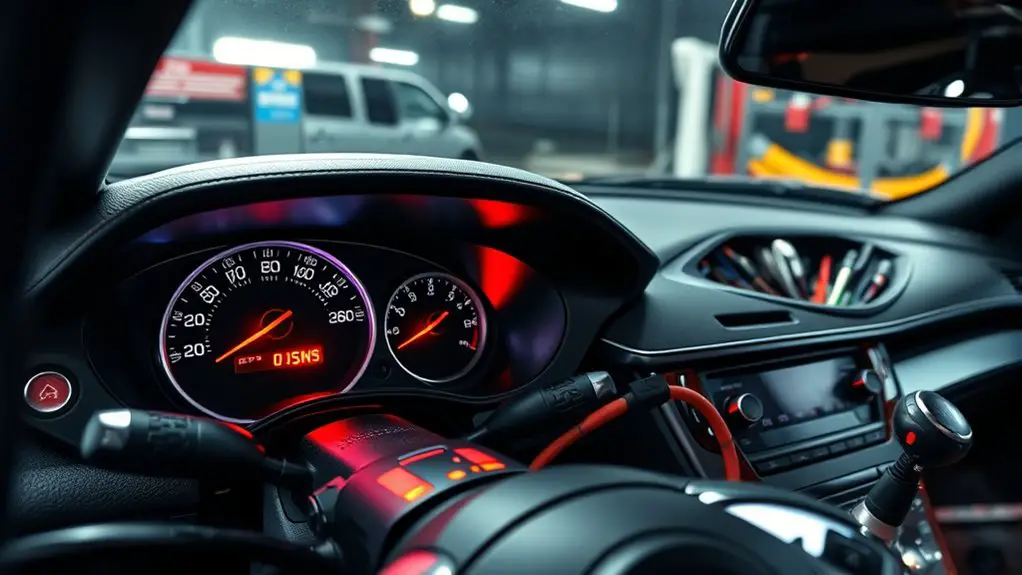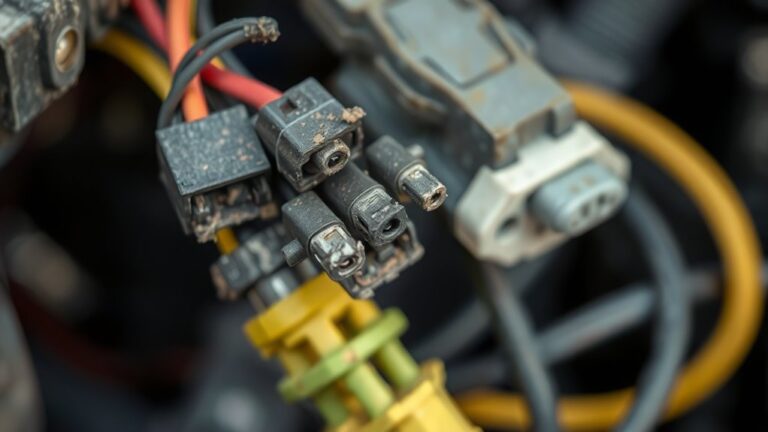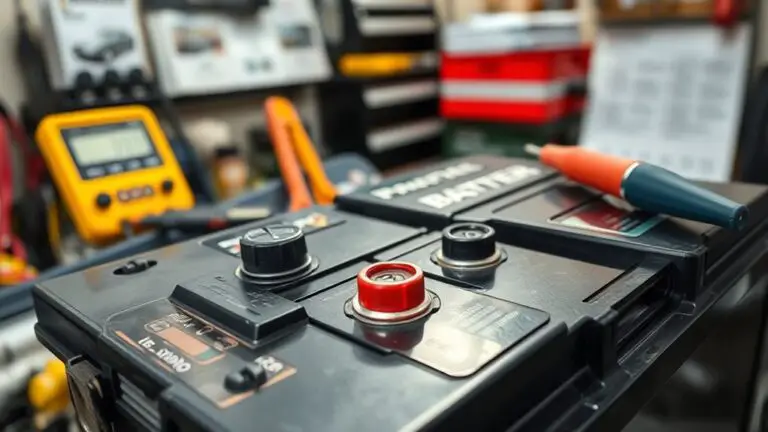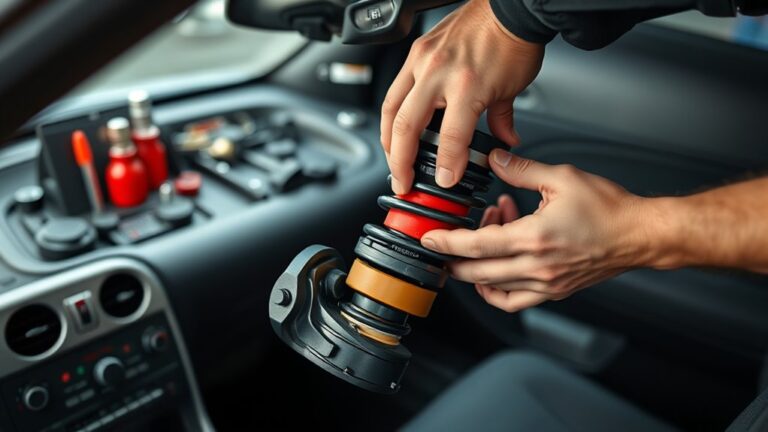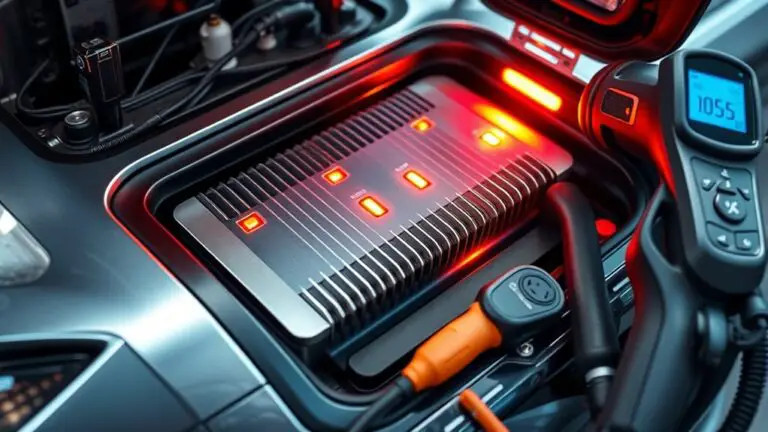How to Stop Parasitic Charging Light on Dash Draining Your Battery
To stop the dash parasitic drain, start by confirming a low, off-state current draw with a precise DC ammeter. Inspect fuses, relays, ignition circuits, and aftermarket installs that may stay energized when the key is off. Disconnect modules one by one to locate the culprit, and inspect harnesses for damaged insulation or leakage paths. Replace faulty relays, fix miswired ignition lines, and make certain of clean grounds. If issues persist, expert diagnostics can pinpoint hidden drains, and more fixes await.
Understanding Parasitic Charging: What It Is and Why It Drains Your Battery

Parasitic charging refers to the continuous draw of current from your vehicle’s battery by components or devices when the engine is off. You’ll want a precise picture of how this works: parasitic battery drain occurs whenever any circuit remains energized after shutoff, slowly depleting stored energy. An electrical system overview helps you quantify this load, separating critical loads from nonessential ones. Typical culprits include clocks, memory modules, and electronic control units that retain data or monitor conditions, all demanding standby current. Measuring the drain with a low-amperage meter reveals whether you’re within design specs or exceeding them. Understanding the baseline helps you interpret sudden voltage drops and extended crank times. This topic doesn’t prescribe fixes, but it frames the issue so you can approach diagnostics with intention. By knowing where the energy goes when you’re parked, you gain clarity, control, and independence from unpredictable battery behavior.
Common Suspects for Dash Drain: Aftermarket Electronics, Relays, and Ignition Circuits
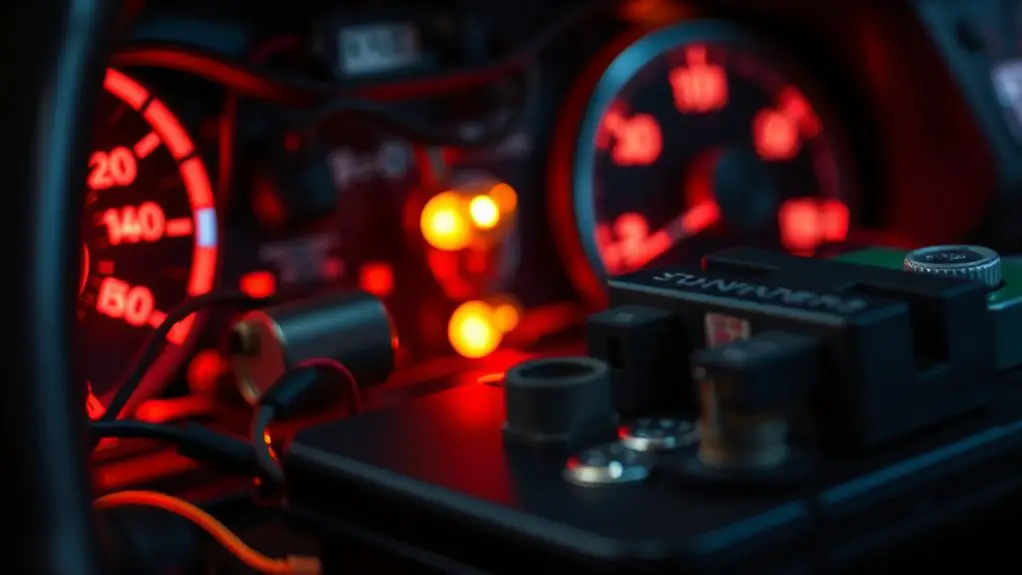
Aftermarket electronics, relays, and ignition circuits are the most common culprits when dash drain appears. You’ll want to audit what each device does, how it’s wired, and whether its standby current is excessive. Focus on aftermarket installations that tap into the vehicle’s power or ground paths, since subtle draws accumulate across hours of idle time. Relays can leak or stick, keeping circuits energized when you expect them off; verify coil resistance and contact integrity, and replace corroded or welded relays with proper automotive-rated parts. Ignition circuits are particularly sneaky: even when the key is off, accessories wired through the ignition switch may remain energized if the wiring is misrouted or fused incorrectly. Inspect harnesses for compromised insulation, pinched wires, and improper splices that create parallel paths. Review electrical components for compatibility with your vehicle’s ECU and fuse box layout, ensuring loads are within design limits and using dedicated circuits where appropriate. Precision checks prevent incremental drain from becoming a reliability risk.
How to Measure Current Draw Safely: Tools and Step-by-Step Method
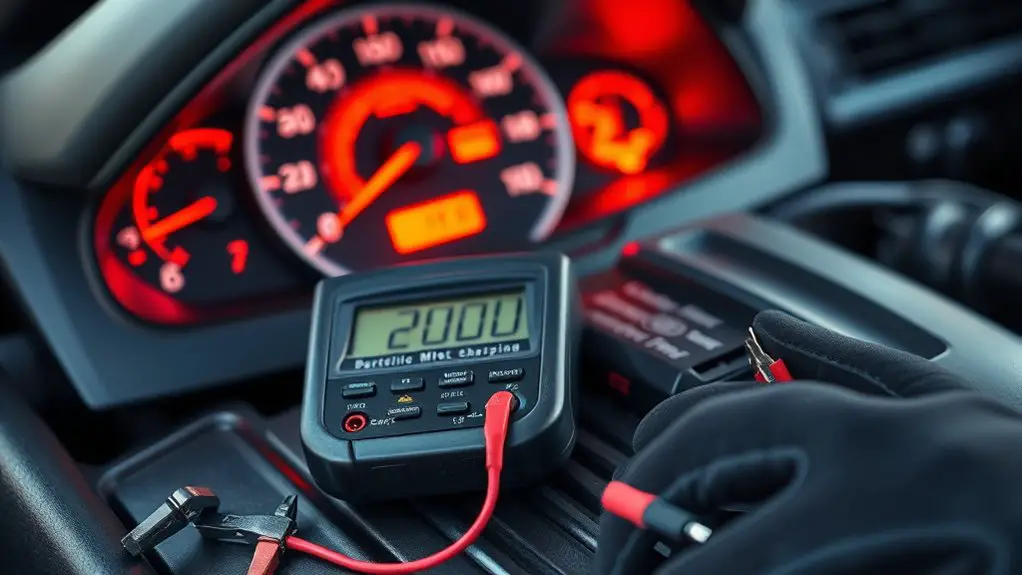
To measure current draw safely, you’ll start with Safe Measurement Basics to protect both you and the vehicle’s electrical system. You’ll reference the Tools You’ll Need to select the right clamp meter or inline ammeter and appropriate fusing, then follow a Step-By-Step Method that guarantees accurate readings without shorting circuits. This intro sets the foundation for precise, repeatable tests you can trust when diagnosing parasitic draw.
Safe Measurement Basics
Measuring current draw safely starts with choosing the right tool and understanding the risks. You’ll use a precision ammeter or a clamp meter designed for DC automotive circuits, ensuring it tolerates the expected current and voltage. Before you connect anything, inspect cables for damage and disconnect battery power if required by the procedure. Follow safe measurement techniques: establish a stable, low-resistance path, minimize contact resistance, and avoid shorting adjacent conductors. Use proper input jacks, verify unit scales, and record baseline readings on a known-good system. Maintain electrical safety precautions, including eye protection and insulated gloves, and keep metal tools away from live contacts. Document measurements, note environmental conditions, and repeat to confirm accuracy. This disciplined approach protects you while identifying parasitic loads efficiently.
Tools You’Ll Need
To safely measure current draw, you’ll need a set of tools designed for DC automotive circuits and low-resistance accuracy. Start with a calibrated clamp meter or a precision inline ammeter capable of milliamps to amps, plus a high-quality multimeter for voltage checks. A low-resistance shunt resistor and proper insulated test leads guarantee minimal measurement error. For safety, include insulated gloves and eye protection, plus a fuse-protected measurement method to prevent shorts. A portable, battery-powered oscilloscope or data logger helps capture transient parasitic events without engine load. Documentation tools for logging readings support repeatability in battery maintenance. Choose tools with automotive-grade durability and clear measurement ranges. Your aim is reliable data capture, enabling informed decisions while preserving vehicle electrical system integrity. Essential tools streamline safe analysis and empower freedom in diagnostics.
Step-By-Step Method
Begin by setting up your measurement path with safety and accuracy in mind: connect a calibrated inline ammeter or a precision shunt in the supply line feeding the vehicle’s battery, guaranteeing the meter can read from milliamps to amps and has proper automotive-rated leads. With power off, isolate the battery, then reattach the negative terminal through the meter, avoiding shorts. Power the system and observe the draw, noting baseline parasitic current. Subtract any intentional loads and confirm stability over several minutes. Move through components sequentially—fuses, relays, ECUs—measuring each path’s draw. Record deviations, then disconnect suspected modules to isolate the culprit. Document findings for battery maintenance and electrical systems logs, rechecking after remediation. Ascertain all wiring remains secure, and re-test to verify a reduced parasitic drain.
Diagnostic Steps to Identify the Culprit: Systematic Troubleshooting
Start with a structured diagnostic plan to identify the culprit by applying Systematic Troubleshooting Steps. You’ll first Identify Electrical Draw to confirm where the parasitic load originates, then Verify Power States across key modules to spot abnormal canaries in the system. Use concise measurements and documented observations to guide follow-up testing and isolate the responsible circuit.
Systematic Troubleshooting Steps
Systematic troubleshooting begins with a clear, step-by-step plan to locate the culprit behind parasitic charging. You’ll map the circuit, isolate the parasitic path, and measure draw across the battery while the vehicle is off. Begin by confirming the dash light behavior, then check fuses, relays, and the ignition switch for unintended energization. Use a multimeter to log current draw at key points, noting any anomalies. If the draw exceeds expected baseline, methodically disconnect modules one at a time, observing changes to the meter reading. Document findings with timestamps, then correlate anomalies to recent repairs or aftermarket devices. Focus on common causes, and apply battery maintenance practices—clean connectors, proper grounding, and secure harnesses. Maintain a disciplined, data-driven approach to avoid unnecessary resets or guesses.
Identify Electrical Draw
To identify the electrical draw, start by establishing a baseline of current when the vehicle is off and all accessories are at rest; this will help you spot small, persistent drifts. Then measure accessory currents individually with a multimeter in series, noting any exceeds beyond manufacturer specs. Prioritize gateways like the ignition, ECU, and infotainment; isolate each circuit, then recheck the baseline to confirm a variance. If you detect an abnormal draw, trace wiring paths, verify diode and fuse integrity, and assess relays for sticking contacts. Document findings for battery maintenance and plan corrective action. Maintain electrical safety throughout: disconnect power only with appropriate tools, avoid shorting, and respect high-current paths. Precision, not guesswork, yields reliable diagnostics and safer automotive operation.
Verify Power States
Next, you’ll verify power states to pinpoint the culprit. Systematic power-state verification is your first diagnostic lever. Begin with a baseline assessment of idle vs. active modes, noting any unexpected shifts. Use targeted tests to confirm that modules enter sleep, wake, and low-power states as designed, and record timestamps for each state change. Conduct voltage checks across critical rails during these shifts, verifying that regulators maintain spec’d levels within tolerance. Check for parasitic paths that bypass normal control signals, and validate that load currents align with documented profiles for each state. Document any deviations, repeat trials, and compare against vehicle service data. This disciplined approach isolates the component or subsystem prompting unexpected drain, guiding precise remediation without unnecessary disassembly.
Fixes and Best Practices: From Simple Disconnections to Replacements
When addressing parasitic charging on the dash, start with simple disconnections to isolate the source and verify there’s no lingering load, then proceed to targeted fixes. You’ll methodically map the circuit, unplug optional accessories, and confirm battery state with a multimeter. If the dash light extinguishes, you’ve identified a consumer; leave it disconnected for testing, then reintroduce items one by one. Next, inspect connectors for corrosion, damaged insulation, and loose grounds, replacing compromised parts to restore stable draw. Implement disciplined battery maintenance by prioritizing clean terminals, correct torque on fasteners, and shielded wiring routes to minimize parasitic paths. When simple disconnections fail, pursue electrical upgrades that strategically reduce steady-state draw—for example, modern ignition relays, smart power modules, or low-standby microcontrollers. Document each change, monitor voltage under sleep conditions, and verify a return to baseline. Always balance performance with safety and compatibility, avoiding overengineering and unnecessary complexity.
When to Seek Professional Help and Preventive Tips for the Road Ahead
If the parasitic draw persists after methodical troubleshooting, seek professional help to avoid electrical misdiagnoses or safety risks; a trained technician can perform diagnostic testing, load profiling, and harness inspections that require specialized tools and knowledge. You’ll benefit from an objective assessment that distinguishes battery wear, relay faults, and module quirks from user-driven drain. When professional diagnostics identify the root cause, implement targeted repairs and verify system integrity with post-repair testing. To support long-term reliability, engage in disciplined battery maintenance: check parasitic load levels, replace corroded connects, and document component lifecycles. Preventive tips for the road ahead include scheduling periodic system audits, maintaining clean grounds, and avoiding aftermarket modifications that introduce uncontrolled draw. Keep a maintenance log, monitor draw patterns, and address anomalies promptly. By coupling proactive checks with informed decisions, you preserve reserve capacity, extend battery life, and sustain freedom to travel without unexpected stops.
Frequently Asked Questions
Can Parasitic Drain Be Caused by Factory-Installed Features?
Yes, parasitic drain can be caused by factory features. Some factory-installed electronics stay active or misbehave, pulling current even when you’re not using the vehicle. You should audit each feature, disable nonessential options, and monitor draw for battery maintenance. Consider consulting the service manual to identify circuits, and perform a controlled shutoff test. If you’re unsure, seek professional help; preserving power respects your freedom and guarantees reliable starts.
Do Smart Dashboards Contribute to Overnight Battery Drain?
Do smart dashboards contribute to overnight battery drain? Yes, they can, but you can control it. You’ll find that smart technology and dashboard features consume standby current; disable unnecessary daemons, dim the screen, and adjust wake/sleep timers. If you want freedom, prioritize critical data displays and keep off nonessential widgets. Use low-power modes and firmware updates to minimize parasitic losses without sacrificing visibility or responsiveness.
Will Cold Weather Worsen Parasitic Charging Issues?
Cold temperatures can worsen parasitic charging issues, affecting battery performance. You’ll notice higher residual draw in colder conditions as electronics may stay active longer and charging circuits behave differently. In practice, you should monitor the dash indicator, verify module sleep modes, and consider battery conditioning or insulation if you park for extended periods. You’ll protect performance by keeping a steady state temperature when possible and using components rated for low-temperature operation.
How Long Should a Car Battery Last With Parasitic Drain?
A parasitic drain can greatly shorten battery lifespan; with a typical 12V lead‑acid battery, you might see it last only a fraction of its normal years, often weeks to months if the drain is ongoing. If you notice drain symptoms—rapid dimming, hard starts, or unexplained after‑glow—you should diagnose promptly. Expect longer life if you fix the fault and minimize standby loads; otherwise, replacement may be needed sooner than you expect.
Can Aftermarket Alarms Trigger Continuous Current Draw?
Yes, aftermarket alarms can trigger continuous current draw if they’re wired or configured improperly, especially when features like shock sensors or door relays remain active. To prevent this, guarantee proper battery management is in place: verifying wiring diagrams, using relays, and disabling unused circuits. Regular checks with a multimeter help you spot parasitic draws. You’ll gain freedom by choosing reputable systems, configuring sleep modes, and confirming the alarm won’t drain the battery when parked.

